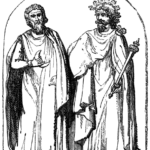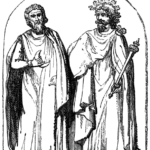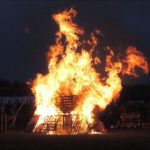First Rites
First Rites marks the point where a Celtic child becomes an adult after the rites they take on responsibility for themselves and their actions; they officially become adults in the eyes and minds of the community. Throughout history there have been a lot of different ways cultures acknowledge a child’s entrance into adulthood: The Jewish faith conducts either a Bat Mitzvahs or Bar Mitzvahs during the thirteenth year of a person’s life. Inca children were given several tests or tasks to accomplish and only became “official” tribe members after completion. The Celtic religion practices the act of first rites. All of these societies and many more have a distinct point where children are treated as adults and expected to undertake adult responsibilities.
Unfortunately American society, in general, has no similar concept when children enter adulthood. They gradually place more responsibility on the children but there is no specific point when the child becomes an adult. This seems to leave a lot of confusion in the mind of both the children and the community about how to treat the teenage population. After the first rites, the child is an adult to all of the community. They undertake adult responsibilities, are expected to behave in an adult manner and are held accountable in the same ways as other adults. While the age may be as young as 10 (usually 12 to 16); adult status is still granted. To those who lack familiarity with the concept, this is often difficult to accept and understand.
First rites are given to both boys and girls in a small ceremony.
The ceremony for girls traditionally occurs during the first Summer Solstice after the girl has her menstrual cycle. The ceremony for boys to become men is conducted over one moon time frame, usually during the time of the spring or fall equinox sometime after the start of puberty (originally only after the first major successful hunt).
An adaptation that has occurred in recent years is for the girl to be permitted to defer her rites for several years until ready to undertake adult responsibility. From a belief and following standpoint, there are two driving forces for the general acceptance of this change in tradition. The most common sited is that in the founding of these traditions lifespan was shorter. It was not uncommon for a person of 16 to already have a home of their own and at least one kid. To take that into consideration in America today the age has risen to 24 to 26 to have a house and child. The other reason is not talked about as much; girls today enter puberty at a younger age. It is becoming more common for girls at age 8 or 9 to start their periods. Expecting someone this young to undertake the responsibilities of adulthood and possibly running a household is unrealistic. Up until this point, there has been very little if any age adjustment given to the boys of the culture, for the most part, rites are still held around the ages of 13 to 15.
The first rites for boys are much less formal than those for girls. Usually, within one to two years of entering puberty, when a boy decides he is ready, a woman is chosen to introduce the boy into adulthood. She teaches him for one moon period how to treat women properly. What this includes is not only related to “in bed” but in life as well. She reinforces to him that respect and caring must always be given to a woman. He learns what it means to be a man of a household; and the responsibilities that include. He is directed how to give women pleasure and to not just look out for his own. Very few who have had the ceremony do not experience personal and spiritual growth. These rites guide a man throughout his life and encourage him to always remember what he learned about the responsibilities of a man and respecting women.
The rites for girls are usually a formal celebration.
Traditionally there is a three-day party/feast with the rites given on the night of the last day (summer solstice). On the first day, the parents or female elders present the girl with the man they have chosen to bring her into adulthood. If she approves of the choice then rites occur on day 3; if the choice is not acceptable then another man is chosen. If a replacement is needed, they too are presented before the ceremony itself.
 Essentially the ceremony designed to ensure a young woman’s first time with a man is gentle, considerate, and that she is properly opened into womanhood. Relating this belief to modern American society is simple: A majority of girls experience sex for the first time around the age of 15. Unfortunately, most of these girls’ experiences will amount to having some boy (with no idea how to please a girl) flop around on top of them and just jam his penis in repeatedly. It is neither the boy’s or the girl’s fault they simply have not been taught what do to or expect. This event is seldom pleasurable and can even be traumatic. It is a core Celtic belief that all relations should be enjoyed by everyone involved; the first time even more so.
Essentially the ceremony designed to ensure a young woman’s first time with a man is gentle, considerate, and that she is properly opened into womanhood. Relating this belief to modern American society is simple: A majority of girls experience sex for the first time around the age of 15. Unfortunately, most of these girls’ experiences will amount to having some boy (with no idea how to please a girl) flop around on top of them and just jam his penis in repeatedly. It is neither the boy’s or the girl’s fault they simply have not been taught what do to or expect. This event is seldom pleasurable and can even be traumatic. It is a core Celtic belief that all relations should be enjoyed by everyone involved; the first time even more so.
Occasionally (although a lot less common now than in the past) a child will result from first rites. These children are considered very lucky and a sign that the new man or woman is destined to be a great husband or wife. There is considered to be no commitment associated with first rites and no union can occur between the new man or woman and their partner. This poses many problems in today’s culture, so of-late birth control is often used to prevent complications of this type. On very rare occasions a boy or girl may lack the “desire” for the opposite sex when this occurs they may be encouraged to undergo first rites in the “normal” manner however nothing is forced. If the boy or girl is firm in her desires they may elect to have first rites with another of the same sex. This is not a common occurrence because (baring abuse) most people do not realize a desire for the same sex until after first rites. NOTE: Celtic society as a whole has no negative opinions or repercussions for same-sex pairings.
Strict taboos associated with first rites
The primary one is that no one is forced to undertake the first rites at any time. The individual has the right to chose to delay rites or deny any partner. Next, it is considered a very important test of a person (especially a girl’s) character to wait until the first rites to experience sexual relations. This can be a hard test for those who begin menstruating shortly after the summer meeting if there are several girls waiting for the first rites that may also occur during the Winter Solstice. Those who experiment beforehand are looked down upon and considered to lack self-control.
After the first rites, there can be no future relationship between those involved for a minimum period of two years. This is meant to prevent attachments from forming based solely upon the rites. The rites are meant to be an induction into adulthood and not a permanent mating.
Finally, there is no returning to childhood after the first rites. A person is now a man or woman with all that entails, they may or may not continue to live with their parents and may or may not continue to have relationships but they are expected to be a responsible member of society.
What is Marriage in a Celtic Belief?

Marriage within the Celtic belief is not necessarily related to sexual activity; there is no stigma associated with having relations outside of marriage. The wedding itself is usually a private affair with no guests or witnesses, in fact, the wedding may lead some people to associations that are inappropriate. Rather than think of a wedding, it is more fitting to think of a joining of two people. In the belief getting married is a three-step process preformed with intent: 1) Pledge love for each other. Both people pledge that they love each other in some way, some say vows, some write/say a poem some just say “I love you”; whatever way is chosen it entirely up to them. 2) Cook each other a meal. This has been slightly modified to be a home-cooked meal over the last 50 years or so. Depending on the circumstances the meal may be cooked together or separately and usually does not include family and friends. 3) Spend the night together; consummate the marriage. The couple is now married. Reception is often held on a latter-day to announce the marriage to family and friends. It is during this time that people give gifts and express wishes for the future. This is similar to most receptions occurring today.
Separations are usually moderately relaxed and reached by mutual consent.
If there are questions of ownership, monetary issues or custody of children then the Elders Counsel is addressed. Overall the couple should be mature enough to agree that things are not working and end the marriage before it reaches the point of the couple being on bad terms. At that time items are divided, custody of children is arranged and the “divorce” occurs. If things do progress to the point where the couple cannot work things out; both parties are regarded as less desirable for marriage in the future.
Current marriage and divorce laws do little to encompass the Celtic belief and the necessary adaptations have to be made.
The legal marriage can be done in two ways; the couple can go to the justice of the peace and get married thereafter the actual wedding or in some areas, a member of the Elders Council is able to sign the marriage certificate. To attain a divorce it is required in America and elsewhere to go through formal proceedings in a court.
Another legal problem in some areas is that marriage is not limited to man and woman; man and man, woman and woman the joining of three or more people is not totally uncommon. Celtic teachings only state that anyone who desires to join may do so; the circumstances are of less importance then desire.





